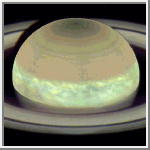|
COMETS EARTH JUPITER KUIPER BELT MARS MERCURY METEORITES NEPTUNE OORT CLOUD PLUTO SATURN SOLAR SYSTEM SPACE SUN URANUS VENUS ORDER PRINTS
PHOTO CATEGORIES SCIENCEVIEWS AMERICAN INDIAN AMPHIBIANS BIRDS BUGS FINE ART FOSSILS THE ISLANDS HISTORICAL PHOTOS MAMMALS OTHER PARKS PLANTS RELIGIOUS REPTILES SCIENCEVIEWS PRINTS
|
Related Document
Download Options
The accompanying movie shows the Saturn white spot, a great storm in the equatorial region of Saturn, discovered by amateur astronomers in September, 1990. Such storms are rare: the last one in the equatorial region occurred in 1933. The movie contains one complete rotation of Saturn. The storm extends completely around the planet, in some places it appears as great masses of clouds and in others as well-organized turbulence. Knowing that this storm is probably a once-in-a-lifetime event, scientists and engineers of a special White Spot Observing Team, the Wide Field/Planetary Camera Team, the Space Telescope Science Institute, and the Goddard Space Flight Center reprogrammed the observing schedule of the Hubble Space Telescope. They were able to get several days of Saturn observations in mid-November 1990, shortly before Saturn moved too near in the sky to the Sun for safe observations by HST. The movie was constructed from red, green, and blue Planetary Camera images obtained during eight successive HST orbits on November 17, 1990. Each of the 24 frames was processed to remove instrumental artifacts and the effects of the HST spherical aberration. The frames were then combined to make the movie by interpolating images of Saturn at uniform intervals of about ten minutes, or six degrees of rotation of Saturn. The color in the movie is approximately "true color." The occasional dark swaths running North-South are an artifact of joining the individual frames. The processed frames reveal detail down to about 700 km (440 miles), but there is some loss in resolution in constructing the movie. For comparison, the diameter of Saturn is about 120,000 km (75,000 miles). The images used in the movie are only about fifteen percent of the data acquired during the November 1990 observing session. By studying all the data, scientists hope to better understand wind speeds in Saturn's atmosphere, the composition and altitude of the clouds, and perhaps help to understand the cause of this great storm. |
